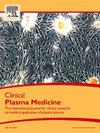Increasing the effectivity of the antimicrobial surface of carbon quantum dots-based nanocomposite by atmospheric pressure plasma
Abstract
Preventing nosocomial infections is one of the most significant challenges in modern medicine. The disinfection of medical facilities and medical devices is crucial in order to prevent the uncontrolled spread of bacteria and viruses. Cost-effective, eco-friendly and fast-acting antibacterial coatings are being developed as the prevention of bacteria and viruses' multiplication on various surfaces. One of the possibilities to create such antimicrobial coatings can rely on a photoactive material, that produces singlet oxygen. However, a remote production of the singlet oxygen and disinfection of the desired surface is a time-consuming process. Hence, a coating material that would autonomously produce singlet oxygen employing ambient light will have a significant impact on the shortening of the disinfection time; leading into an increased number of patients that can be cured in one facility. In this work, an ultra-fast and eco-friendly method for decreasing the disinfection time of the photoactive surface is presented. The atmospheric pressure plasma surface treatment on the hydrophobic carbon quantum dots-polydimethylsiloxane nanocomposite is employed. The plasma-treated samples exhibited improved antibacterial properties compared to non-plasma treated samples, with the best results obtained after only 30 seconds of plasma treatment. The short duration and the scalability potential of the here described method open new possibilities of how to improve the already existing antibacterial coatings.

 求助内容:
求助内容: 应助结果提醒方式:
应助结果提醒方式:


